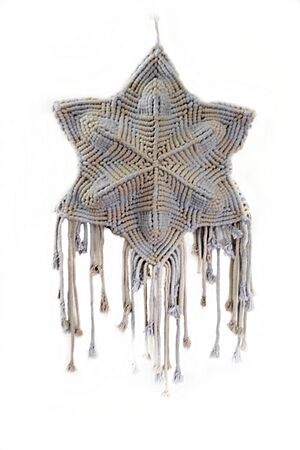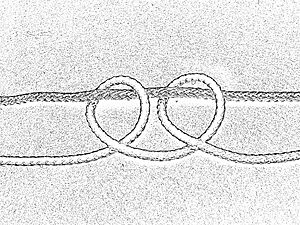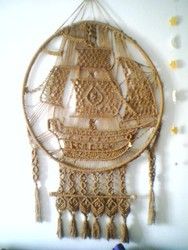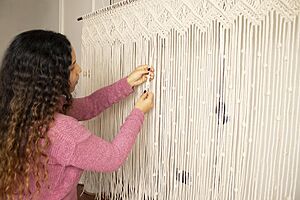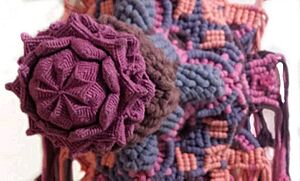Macramé facts for kids
Macramé is a fun and creative way to make textiles using only knots! Instead of weaving or knitting, you tie cords together in special patterns. It's like drawing with string!
The main knots in macramé are the square knot and different kinds of half-hitches. Long ago, sailors used macramé a lot. They made fancy knots to decorate things like knife handles, bottles, and even parts of their ships.
One special type is Cavandoli macramé. It creates cool geometric shapes and free-form designs, almost like a woven fabric. This style mostly uses one knot, called the double half-hitch.
You might have seen macramé without even knowing it! Many friendship bracelets that kids and teens exchange are made using these knotting methods. You can also find macramé jewelry or decorations sold at parks, malls, and craft fairs.
Contents
A Journey Through Time: Macramé's History
Ancient Beginnings
Macramé has a very long history! Some of the earliest examples of decorative knots were found in carvings from ancient Babylon and Assyria. People in these ancient lands used fringe-like braids and knots to decorate their clothes. These designs were even shown on their stone statues.
Spreading Across the World
Later, Arab weavers created a type of decorated cloth called miqrama. They would knot extra threads along the edges of fabrics like towels and shawls to make beautiful fringes. The word "macramé" might come from the Arabic word makramiyya, which means "striped towel" or "ornamental fringe." Another idea is that it came from the Turkish word makrama, meaning "napkin" or "towel." These decorative fringes also had a practical use: they helped keep flies away from camels and horses in northern Africa.
The craft of macramé traveled to Spain when the Muslims arrived there. From Spain, it spread to Italy, especially in a region called Liguria, and then across the rest of Europe. In England, it became popular in the late 1600s. Queen Mary II even taught macramé to the ladies who served her at court!
Macramé's Comebacks
Macramé was very popular during the Victorian era (the 1800s). Many homes had macramé items like tablecloths, bedspreads, and curtains. Books like Sylvia's Book of Macramé Lace (1882) showed people how to make fancy decorations for clothes and household items.
Sailors were also big fans of macramé. When they weren't busy at sea, they would make macramé objects. They would then sell or trade these items when their ships docked. British and American sailors in the 1800s made hammocks, bell fringes, and belts using macramé. They often called it "square knotting" because the square knot was one of their favorites.
After a while, macramé became less popular. But it made a big comeback in the 1970s! People started making cool wall hangings, plant hangers, and even clothing accessories. Macramé jewelry also became very trendy in America. This jewelry often featured square knots and granny knots, along with glass beads, bone, or shells. Necklaces, anklets, and bracelets were all popular.
Macramé's popularity faded again in the early 1980s. However, it saw another brief return to fashion in the late 2010s, showing that this ancient craft can always find new fans!
Getting Started: Materials and Tools
Choosing Your Cords
To make macramé, you need cords! These can be made from many different materials. Common choices include cotton twine, linen, hemp, jute, leather, or yarn. Cords are often described by how they are made, like a "3-ply cord," which means three strands of fiber are twisted together.
If you're making jewelry, you might combine your knots with pretty beads made of glass or wood. You can also add pendants or shells. Sometimes, people use special "found" items like rings or gemstones as the center of a necklace. These can be wrapped with wire or held in place by a net of knots.
Essential Tools for Knotting
When you're working on a macramé project, you'll often use a special knotting board. This board helps you hold your cords in place. You can secure the cords using C-clamps, straight pins, or other types of pins.
For bigger projects, like wall hangings or window coverings, you might start by attaching your cords to a wooden or metal dowel. This makes it easy to spread out many cords and work with them. For smaller projects, special push-pin boards are available, but a simple corkboard works just as well. Many craft stores sell beginner kits, boards, beads, and materials to help you start your macramé journey!
See Also


